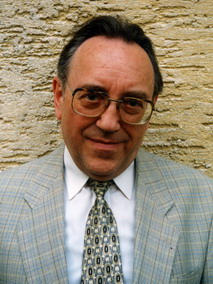Peter Rechenberg
Peter Rechenberg (born July 18, 1933 in Berlin ) is a German-Austrian computer scientist . He worked at the TU Berlin and from 1974–1999 at the Johannes Kepler University Linz .
Life
From 1954 to 1960 Peter Rechenberg studied electrical engineering at the TU Berlin . As a minor, he took music studies at what was then the Hochschule für Musik (now the Berlin University of the Arts ). His diploma thesis in the study of electrical engineering dealt with the settling process of a plucked violin string.
In 1960 he married the pianist Ursula Müller. In the same year he accepted a position at the AEG Institute for Automation in Berlin. As part of this activity, he was able to gain a lot of experience in the field of automation technology, which resulted in his first publication, the book Basics of digital computing systems (1964). His professional career at AEG brought him in contact with a Zuse Z23 , from which he recognized his skills as a software developer. He switched to the AEG research institute, where he was able to use an " IBM 7040 " large-scale computer system. In this position he rose to head a programming lab with three employees. He and his team developed software for the design of printed circuit boards.
From 1966 to 1969 he did his doctorate at the Heinrich Hertz Institute in Berlin with Wolfgang Giloi . His research area was digital simulation. During this time he gave lectures at the TU Berlin on the subject of Fortran programming and the principles of programming languages. His doctoral thesis dealt with a model based on finite automata for the simulation of continuous processes. For this purpose, he also developed a simulation language that combined good concepts from other programming languages known at the time. These were his first steps in the field of compiler construction and the formal languages that would accompany him through his life.
After completing his dissertation, he was given the position of scientific council and professor at the TU Berlin. He became head of a research group on the subject of compiler construction. During this activity, he wrote a standard textbook on PL / I programming.
In 1974 he was appointed to a professorship at the Johannes Kepler University Linz (then University of Social and Economic Sciences ), which had just been founded . He started work in Linz at the beginning of 1975. At the JKU, Rechenberg dealt with software technology, algorithms and data structures, compiler construction and formal languages. With his team he developed a Modula 2 compiler for Intel 8080 processors and later for IBM / 370 computers. An intensive cooperation with the team around Niklaus Wirth , the Modula 2 developer at ETH Zurich , emerged.
He wrote two influential books during the 1990s. In What is Computer Science? he made this scientific discipline understandable for interested laypeople as well. The computer science handbook , which Rechenberg edited together with Gustav Pomberger as editor, developed into a standard work in computer science.
In 1999 he retired .
Fonts
- Books (excerpt)
- as editor with Gustav Pomberger : Informatik-Handbuch. Hanser, Munich et al. 1997, ISBN 3-446-18691-3 .
- What is computer science? A generally understandable introduction. Hanser, Munich 1991, ISBN 3-446-16324-7 .
- Technical writing. (Not only) for computer scientists. Hanser, Munich et al. 2002, ISBN 3-446-21944-7 .
literature
- Günther Blaschek, Alois Ferscha, Hanspeter Mössenböck , Gustav Pomberger (eds.): Peter Rechenberg. Festschrift for the 70th birthday. Rudolf Trauner University Press, Linz 2003, ISBN 3-85487-466-9 .
Web links
- Entry on Peter Rechenberg in the Austria Forum (in the AEIOU Austria Lexicon )
- Homepage at the successor institute of his chair
- Peter Rechenberg - researcher, teacher, human Contribution in Peter Rechenberg: Festschrift for the 70th birthday
- Literature by and about Peter Rechenberg in the catalog of the German National Library
| personal data | |
|---|---|
| SURNAME | Rechenberg, Peter |
| BRIEF DESCRIPTION | German-Austrian computer scientist |
| DATE OF BIRTH | July 18, 1933 |
| PLACE OF BIRTH | Berlin |
